Most feed problems don’t show up as red errors. They show up as performance leaks. Bloated spend on low-intent queries. Strong SKUs that never scale. Campaigns that technically “run” but never hit stride.
The usual assumption? “Feed looks clean, must be a campaign issue.” But if your product data is incomplete, vague, or misaligned, every smart campaign you run will be aiming at the wrong targets. PMax, Meta, Microsoft—they all read your feed like a brief. If it’s full of blanks or bad signals, the automation doesn't know what to optimize for.
That’s where this breaks: poor product data doesn’t just kill eligibility—it confuses the machine. And if you’ve ever dumped budget into campaigns that should work and can’t figure out why they don’t, this is probably the part no one flagged.
High Spend, Low Conversions—But Everything Looks Fine?
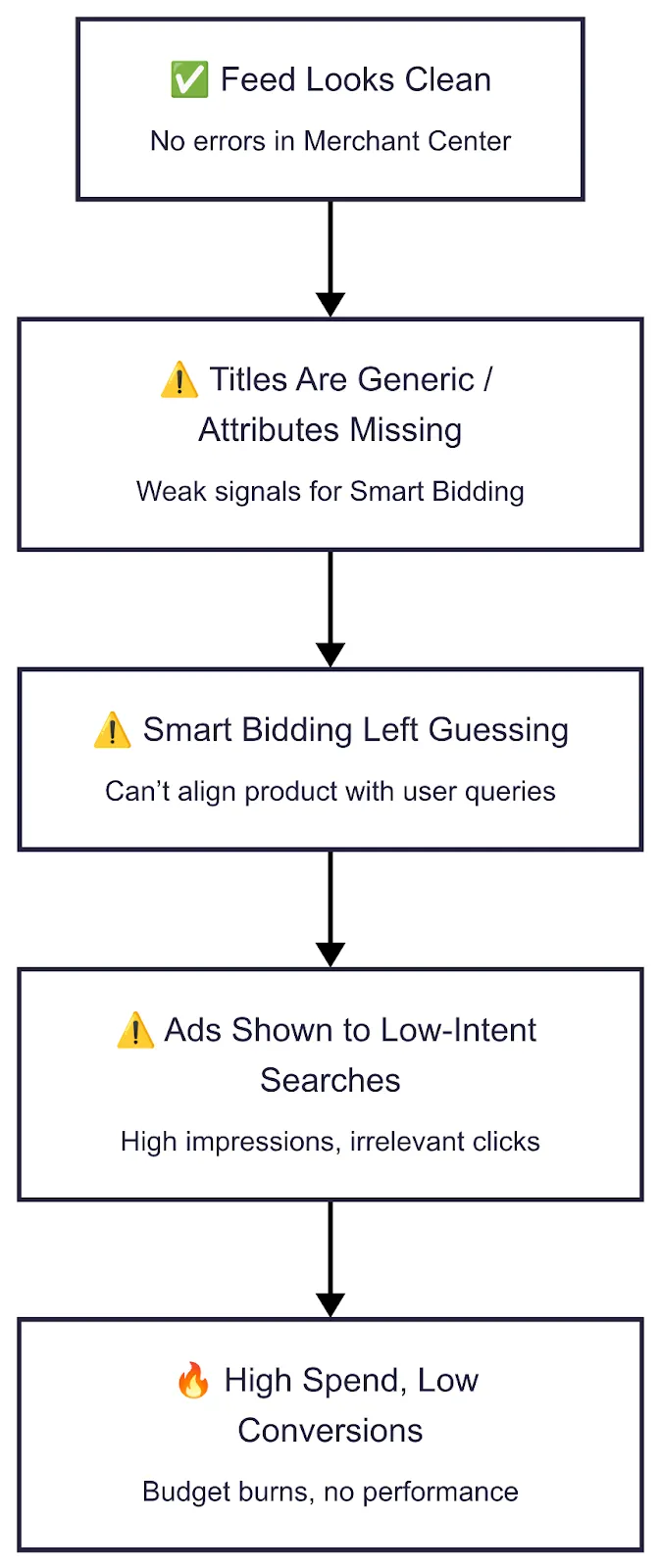
This one slips past a lot of teams. Feed looks clean. Everything’s “active” in Google Merchant Center. Product pages are live. But your Performance Max campaign is burning budget and barely converting.
Here’s where it usually breaks: the platform’s getting weak signals. Titles are generic. Key attributes are missing. So Smart Bidding is left guessing what the product is—and who it's for.
Instead of showing your waterproof men’s trail runners to someone searching “Salomon Speedcross 5 waterproof men’s trail shoes,” you’re showing up for queries like “red shoes.” You’ll get impressions. Maybe even clicks. But you’ll never convert profitably.
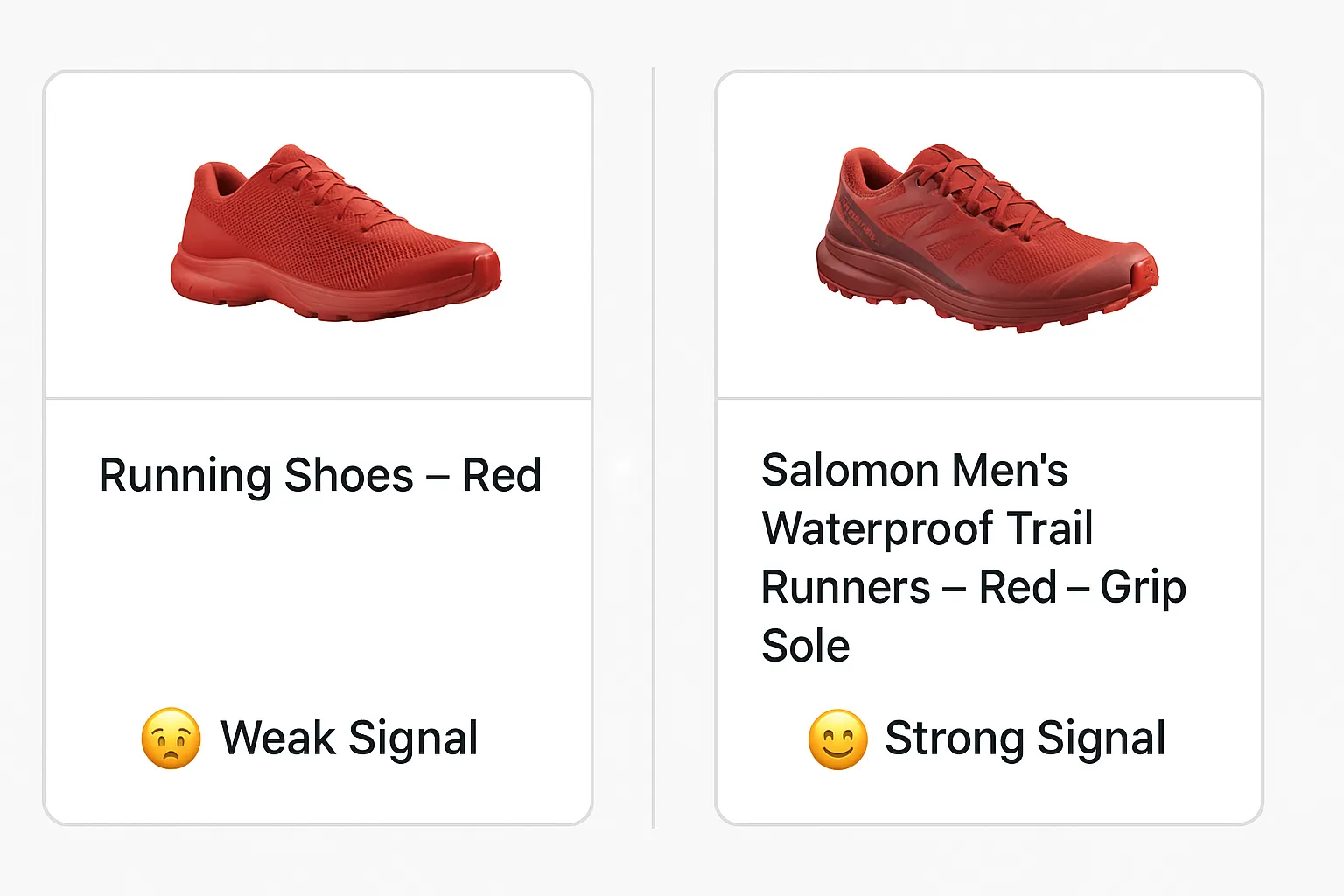
This happens when your feed lacks data points or uses vague values, like these examples:
- Title: “Running Shoes – Red”
- Missing: gender, material, intended use
- Flattened product_type that blocks clean segmentation
[See how to map your feed to fix vague titles and missing attributes.]
That title isn’t just bland—it’s telling the algorithm very little about the product. And when the algorithm has nothing to go on, it starts spending on irrelevant traffic just to learn.
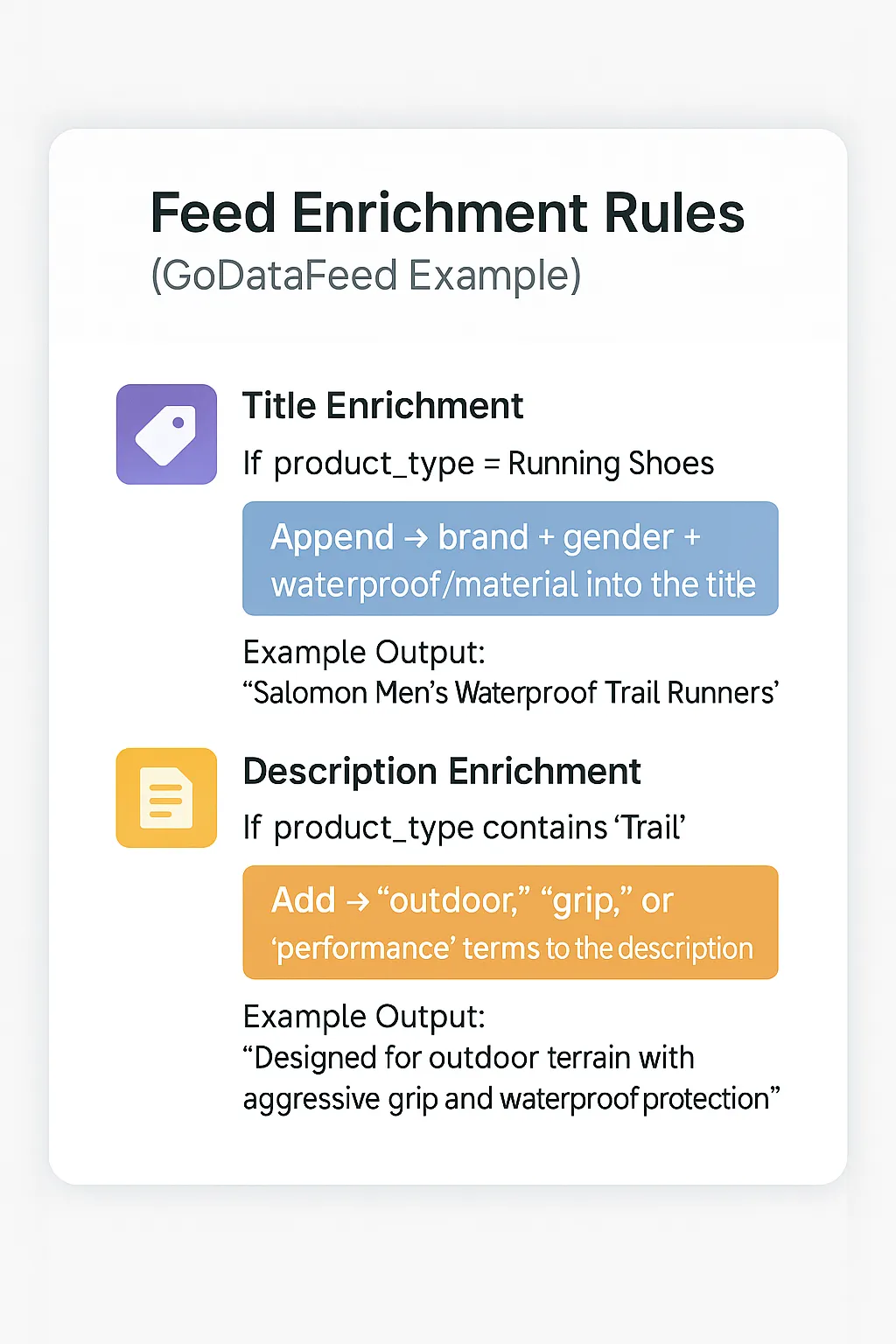
Same thing happens in Meta. If your variant data is thin, your SKUs get lumped into the wrong sets. You end up showing the right product to the wrong audience—or no one at all.
What you actually want is rule-based feed enrichment that fills in the blanks with campaign-relevant detail. For example, in GoDataFeed:
- IF product_type = “Running Shoes”
→ Append: brand + gender + waterproof/material into the title - IF product_type contains “Trail”
→ Add “outdoor,” “grip,” or performance terms to description
This isn’t cleanup—it’s targeting infrastructure. You’re not fixing errors. You’re feeding the algorithm the intent it needs to win.
Your Best-Sellers Aren’t Scaling—Because the Feed Treats Them Like Everything Else
If you’ve got SKUs that crush in manual campaigns or promos—but stall in PMax or Meta—it’s probably not your bidding strategy. It’s your feed.
Here’s where this usually breaks: your top performers look exactly like everything else in the eyes of the platform. No velocity markers. No margin tiers. Just one flat catalog.
When custom labels are empty or misused, Smart Bidding doesn’t know what to prioritize. And when everything’s equal, budget gets spread equally. Which means your winners get buried.
What you actually want is performance-driven label logic—rules that translate business value into campaign structure.
If you’re using GoDataFeed, set up tiering like this:
- IF units_sold_last_30_days > 50 → custom_label_0 = top_seller
- IF margin < 20% → custom_label_1 = low_margin
- IF clearance_flag = true → custom_label_2 = clearance
That gives you a clean way to segment asset groups or Shopping campaigns by what matters. Top sellers go in one group. Clearance gets isolated or suppressed. Low-margin SKUs don’t compete for the same budget.
Feeds without prioritization logic are like ad sets with no audience targeting—everything gets a little, but nothing wins.
[These are classic feed management mistakes—and they kill performance quietly.]
Approved ≠ Delivering: The Silent Drain of Suppressed SKUs
If you’ve ever looked at Merchant Center or Meta Commerce Manager and thought, “Everything’s active, why is delivery flat?”—this is probably the issue.
Here’s where it breaks: products look approved, but they’re silently failing in delivery. No disapproval. No alerts. Just zero impressions.
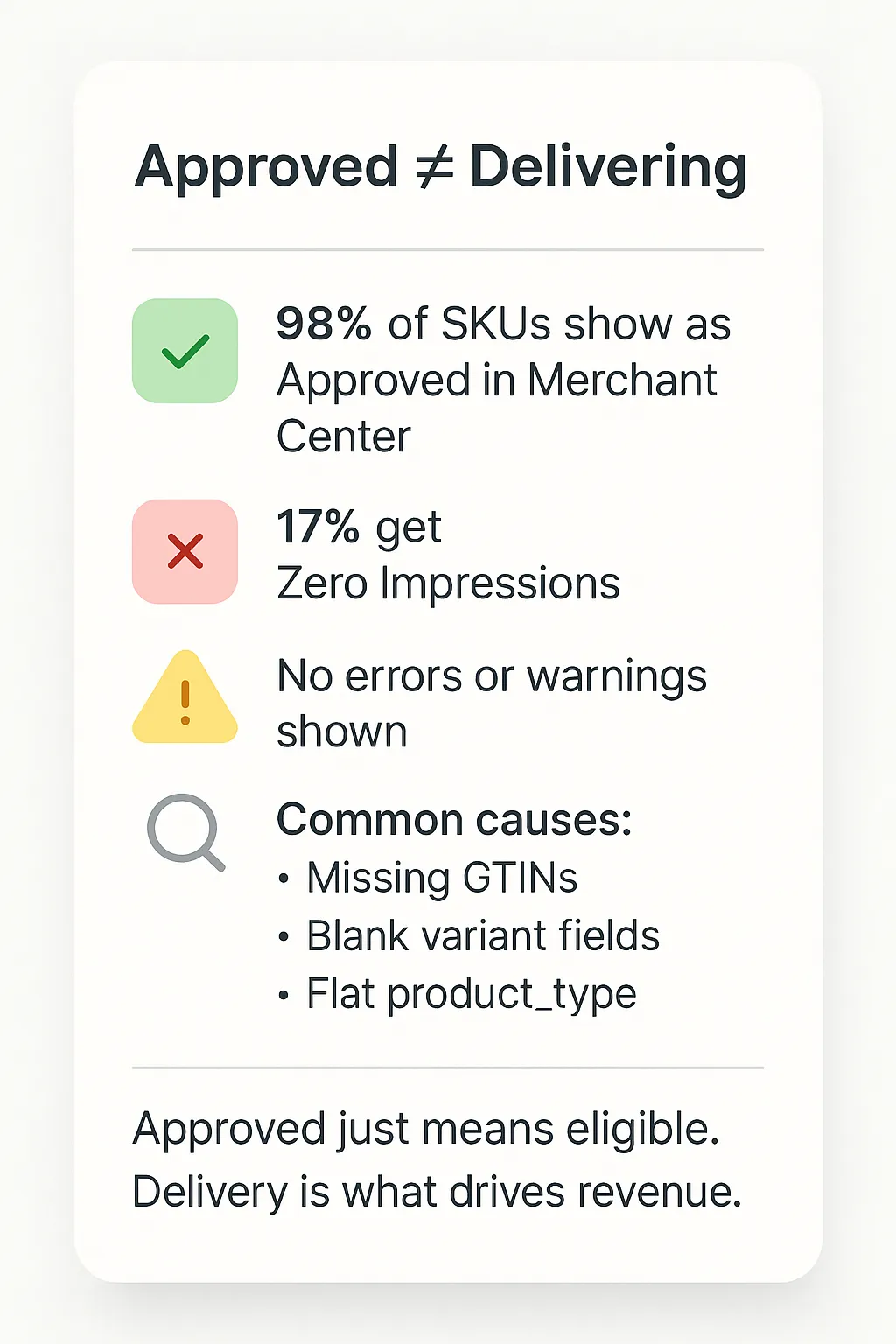
Some real examples:
- Meta suppresses variants missing color or size—even if the parent SKU is “active.”
- Google lets SKUs with missing GTINs show as approved—but they never enter competitive auctions.
- A misclassified or blank product_type can block products from joining dynamic segments or asset groups.
These aren’t red-flag errors. They’re quiet failures. If you’re only watching for warnings, you’ll miss them.
What you actually want to look at is the gap between what’s approved and what’s actually delivering.

Here’s the quick check:
- Pull item-level impressions from Google Ads or Meta reporting.
- Compare against approved SKU count in Merchant Center or Catalog Manager.
- Flag anything that’s approved but got zero impressions in the last 7 days.
That delta is where your feed is leaking revenue.
Fix it at the root:
- Fill in missing attributes (size, color, material) using rule-based enrichment in GoDataFeed.
- Rebuild product_type hierarchies so products map correctly to campaign logic.
- Monitor Meta’s suppressed variant diagnostics—even if it’s buried, it’s there.
“Active” doesn’t mean functional. It just means eligible. And eligibility without delivery is a silent budget drain.
For a deeper breakdown of how to structure feeds to avoid these silent errors, GoDataFeed’s feed setup overview covers field mapping, attribute population, and submission steps in detail.
This Is Where Feed Logic Becomes Campaign Structure
Clean feeds don’t just prevent errors—they enable strategy. Once your data’s enriched, segmented, and aligned, campaign automation starts behaving like it’s supposed to.
[This feed creation tutorial walks through the full import-to-export workflow.]
But when the feed doesn’t match the structure your campaign needs, platforms default to treating everything the same. That’s when PMax flattens your budget across random SKUs, and Meta serves the right product to the wrong person.
Here’s where this matters most:
Google Performance Max
Asset groups aren’t driven by audiences. They’re driven by product structure. If your product_type is sloppy or your custom_label_0 is blank, there’s no way to group SKUs by intent, margin, lifecycle, or volume.
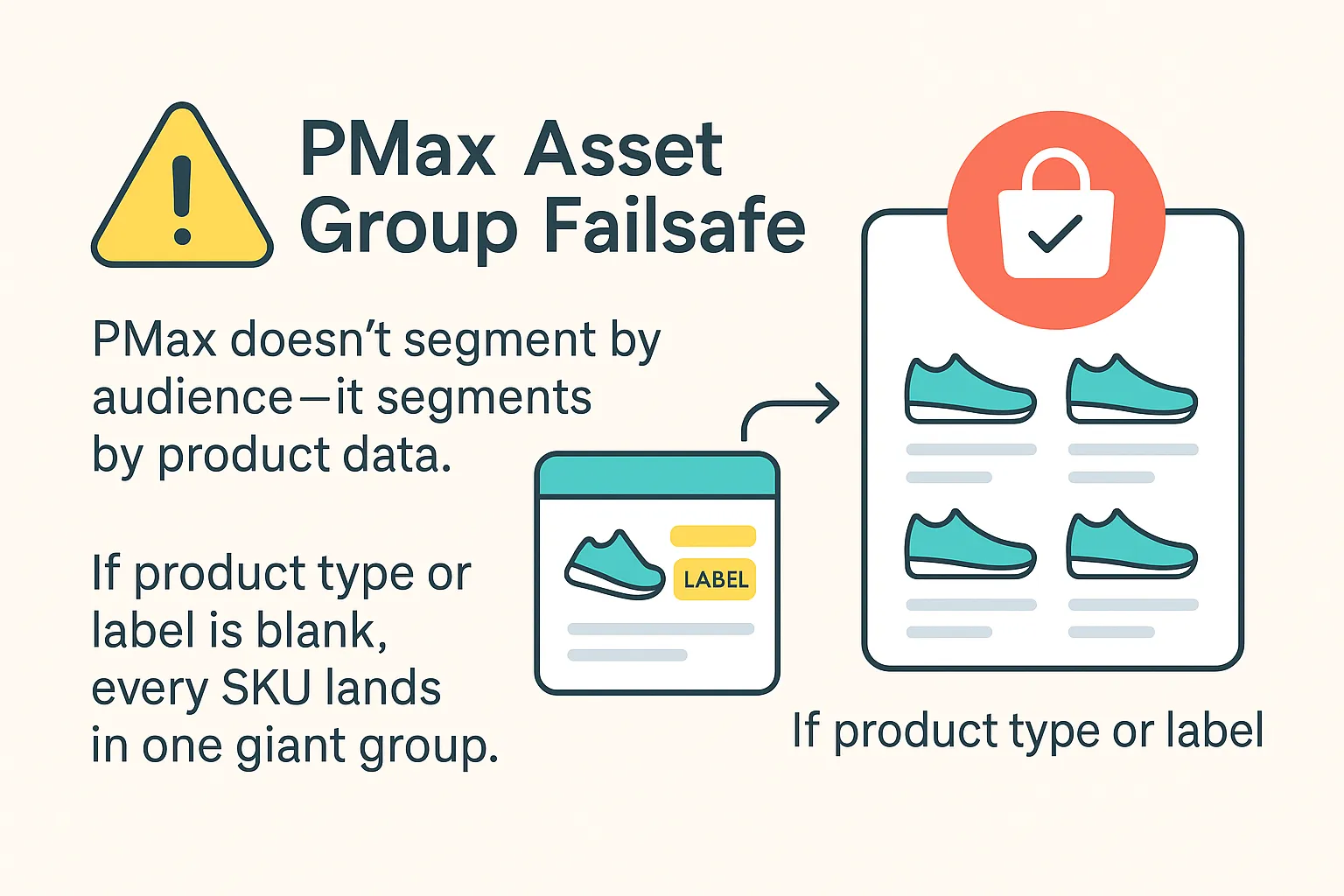
So PMax treats your entire catalog as one big group—and you lose all control over budget direction.
Fix it like this:
- Use GoDataFeed to clean and standardize product_type hierarchies.
- Set custom_label_0 based on performance tiers or business logic:
- custom_label_0 = evergreen_core
- custom_label_0 = seasonal_promo
- custom_label_0 = clearance_q3
Once that’s in place, you can build asset groups that match how your business actually runs. PMax learns faster, bids smarter, and spends where it matters.
Meta Catalog Sales
Same concept. Different signals.
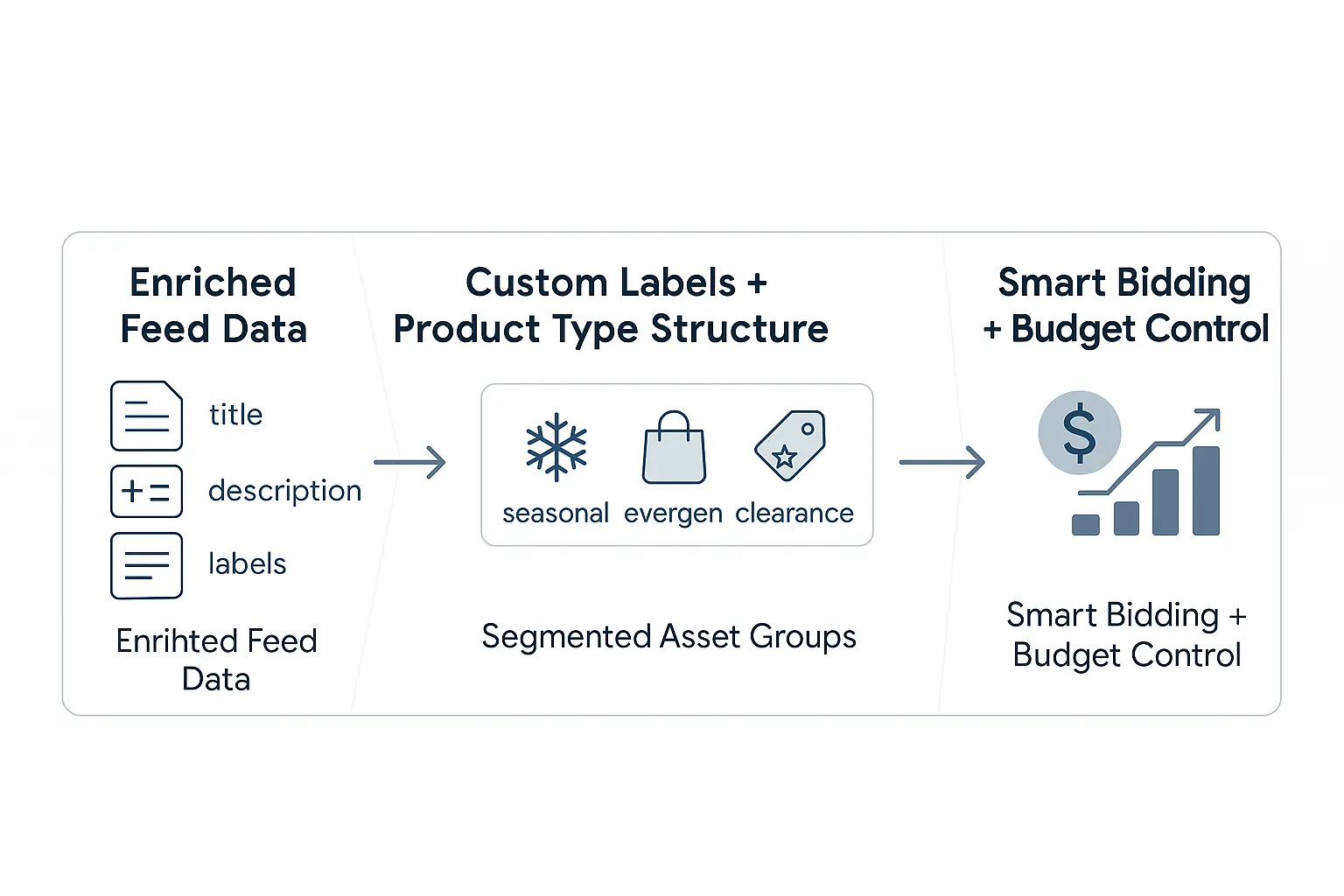
Meta uses variant-level attributes like size, gender, and color to build product sets and serve the right creative. If those fields are missing—or inconsistent—you’ll end up showing mismatched ads or dropping SKUs from delivery entirely.
Fix it like this:
- Use GoDataFeed rules to auto-fill variant attributes based on category logic:
- IF product_type = “Women’s Running Shoes” → gender = female
- Enrich every apparel SKU with consistent values for size, age_group, color, and material.
Without that structure, Meta’s dynamic product ads are just guessing. With it, you’ve got targeting that actually maps to shopper intent.
[This also affects SEO—Meta feeds now impact Google Search.]
You don’t structure feeds for neatness. You do it so campaigns know where to push and where to pull back. When segmentation’s built into the feed, the algorithm has somewhere to go. When it’s not, it just burns budget evenly—and learns nothing.
Bottom Line: If the Feed’s Wrong, the Campaign Never Had a Chance
Campaigns underperform when platforms can’t interpret the feed. And that happens more often than most teams realize—because Merchant Center doesn’t flag vague titles, weak variant data, or flat product_type structures.
Performance Max can’t segment SKUs. Meta can’t assemble product sets. Smart Bidding can’t prioritize based on ROAS tiers. And the result is budget spread thin across unqualified traffic and low-performing inventory.
Fixing that means taking control of the product data layer—before it reaches the channel. A tool like GoDataFeed lets you apply rule logic to titles, attributes, and custom labels so you can structure feeds for campaign performance, not just platform approval.
No dev tickets. No waiting on product or engineering. Just clean, campaign-ready data you control from the marketing side.
Next Step: Run a Delivery Audit by SKU
Here’s a fast way to surface silent failures:
- Pull 30 days of product-level impressions from Google Ads or Meta
- Cross-check against your approved SKU list in Merchant Center or Commerce Manager
- Flag everything that’s approved but has zero delivery
[Clean feeds don’t just help paid—they power free listings too.]
That’s where your feed is failing quietly—and where you start improving campaign performance without touching the campaigns themselves.






%20).webp)